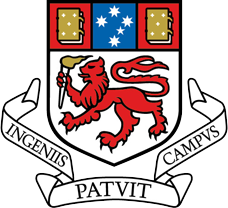
The University of Tasmania (UTAS) is a public research university, primarily located in Tasmania, Australia. Founded in 1890, it is Australia's fourth oldest university. Christ College, one of the university's residential colleges, first proposed in 1840 in Lieutenant-Governor Sir John Franklin's Legislative Council, was modeled on the Oxford and Cambridge colleges, and was founded in 1846, making it the oldest tertiary institution in the country. The university is a sandstone university, a member of the international Association of Commonwealth Universities, and the Association of Southeast Asian Institutions of Higher Learning.

The Hutchins School is an Anglican, day and boarding school for boys from pre-kindergarten to Year 12 in Hobart, Tasmania. Established in 1846, Hutchins is one of the oldest continually operating schools in Australia. The school's students consistently rank among the highest academic achievers in Tasmania and nationally; it has had 24 Rhodes Scholars. The school is located just under four kilometres from the CBD of Hobart, The Hutchins School offers facilities including classrooms, science and computer laboratories, libraries, a performing arts centre, a recording studio and multiple sporting grounds. International students reside in the school's boarding facility, ‘Burbury House’, which in 2012 underwent a full refit and refurbishment. Hutchins is a founding-member of the International Boys’ Schools Coalition (IBSC), and a member of Independent Schools Tasmania (IST).

Guilford Young College is a Roman Catholic senior secondary college, with campuses located in the Hobart suburbs of Glenorchy and Hobart City in Tasmania, Australia. The College provides education to students in Year 11 and Year 12, offering more than 100 Tasmanian Certificate of Education (TCE), pre-tertiary and Vocational Education and Training (VET) courses. The college is named in honour of Sir Guilford Young who served as the eighth Archbishop of Hobart from 1955 to 1988.

St Hilda's School is an independent, Anglican, day and boarding school for girls, located in Southport, a central suburb of the Gold Coast, Queensland, Australia.

Scotch Oakburn College is an independent, open-entry, Early Learning to Year 12, coeducational, day and boarding school in Launceston, Tasmania, in association with the Uniting Church in Australia.

Launceston Church Grammar School is an Anglican co-educational private school in Launceston, Tasmania, Australia for Early Learning through to Grade 12.
Football Tasmania (FT) is the governing body for soccer in the Australian state of Tasmania. The federation oversees competitions across Tasmania, Tasmanian representative teams, and development of the sport in the state. The federation was known as the Tasmanian Soccer Association until 1996, when it was renamed to Soccer Tasmania. In line with national changes in March 2006, it became Football Federation Tasmania. In February 2019, the organisation became simply Football Tasmania.

St Mary's College is a Kinder to Year 12 Catholic, day school for girls, located on the northern city fringe of Hobart, Tasmania, Australia.

St Michael's Collegiate School, colloquially known as Collegiate, is an independent Anglican early learning, primary and secondary day and boarding school for girls. It is located in Hobart, Tasmania, Australia.

The Geelong College is an Australian independent and co-educational day and boarding school located in Newtown, an inner-western suburb of Geelong, Victoria.
St Patrick's College is a coeducational Catholic secondary (7–12) college, located in Launceston, Tasmania. The college has close to 1500 students enrolled.

Santa Sabina College is a multi-campus independent Roman Catholic, single-sex, early learning, primary and secondary day school for girls from Year 5 to Year 12; and a co-educational day school from early learning years through Prep to Year 4. Located on eight hectares in Strathfield, an inner-western suburb of Sydney; and on 97 hectares in Tallong, in the Southern Highlands of New South Wales, Australia; students are educated in the Dominican tradition. Established in 1894, Santa Sabina has a non-selective enrolment policy and as of 2007 catered to approximately 1,400 students.

St Virgil's College is an independent Catholic primary and secondary day school for boys, located over two campuses in Austins Ferry and Hobart, Tasmania, Australia. Established in 1911 by the Congregation of Christian Brothers, the College has a non-selective enrolment policy and caters for approximately 680 students, from Years 3 to 10, with 120 at the junior campus and 480 at the senior campus.

Fahan School is an independent school for girls located in Sandy Bay, a suburb of Hobart, Tasmania, Australia. It is a non-denominational school with a Christian ethos.
The Sports Association of Tasmanian Independent Schools (SATIS) is a group of sixteen schools in Tasmania, Australia formed by AHISA Tasmania to conduct sporting competitions for member schools. NSATIS and SSATIS are regional bodies which organise and conduct competitions in their respective regions.
Tintern Grammar is an independent, Anglican day school for girls and boys located in Ringwood East, a suburb of Melbourne, Victoria, Australia.

MacKillop Catholic College is an independent Roman Catholic co-educational secondary school for Years 7 to 10 in the Hobart suburb of Mornington, Tasmania, Australia. The school is named in honour of the Australian educationalist Mary MacKillop, an Australian nun who has been declared a saint by the Catholic Church. The school also has an association with the Christian Brothers founded by Edmund Rice. MacKillop and Rice are key sources of inspiration for the school community. MacKillop Catholic College is the only Catholic secondary college servicing Hobart's eastern shore.
Sacred Heart College is a catholic school in New Town, Tasmania with an enrollment of 940 students. The schools serves students from kindergarten to year 10.

Calvin Christian School is a coeducational, private Kindergarten to Year 12 Christian school located 12 kilometres south of Hobart, Tasmania in Kingston.
















